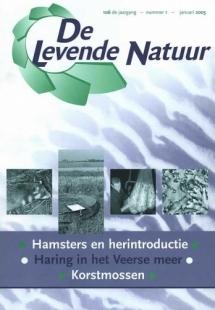De Levende Natuur nummer 1 van 2005 (English summary)
Afbeelding

Conservation of the Dutch hamster population - Implications of genetic research
Jansman, H.A.H. & M.J.M. Smulders
The Common hamster (Cricetus cricetus) almost became extinct in The Netherlands. A rapid collapse of the population lead to an urgent species protection plan, which included captive breeding, recently followed by re-introduction. An important issue for conservation was the genetic status of the Dutch hamster population. In order to determine this, DNA from hamsters was analysed using microsatellite and MHC analysis (nuclear DNA) in combination with mitochondrial DNA analysis. Museum samples showed that the variation was historically already lower than in eastern Europe; genetic evaluation of recently sampled Dutch and Belgium hamsters revealed a nearly complete reduction of genetic variation. The fitness of the hamsters currently seems to be sufficient for survival. However, measures will be necessary to increase genetic variation. It is recommended to exchange individuals between the genetically related Dutch and Belgian populations in order to increase the levels of genetic variation, and therefore the adaptation capacity to changing environmental conditions in the future.
Three years of reintroduction and protection of hamsters in The Netherlands
Haye, M. la, G.J.D.M. Muskens & R.J.M. van Kats
Since 2002 hamsters are released in three hamster-friendly managed sites (Sibbe, Amby and Heer) in the most southern part of The Netherlands in the province of Limburg. As a result of these reintroductions, three small hamster populations are established. The management of the sites resulted too in an enormous amount of Field mice (Microtus arvalis), which is a favorite prey-species for a lot of predators. Unfortunately, the population of mice collapsed in spring due to agricultural activities. The predators (mainly foxes and marders) than switched to other prey and food, with a disastrous effect on the hamster population. Part of the hamster population escaped predation by moving to surroundings fields with a normal agricultural management.The long time survival of the hamster populations depends on the (im)possibility of creating good hamster-habitat patches within the reserves, in the surrounding of the reserves and between the reserves. In the coming years the management of the three sites must be intensified and crops must be cultivated on larger patches, instead of small stripes. Outside the reserves the main problem seems a shortage of cover and the total absence of food for winter-storage.
Herring and water quality in Lake Veere
Kemper, J.H.
In September 2002 a fish stock assessment was carried out in Lake Veere. The brackish water lake is created in 1961, as part of the Delta Works. The study area was divided in four depth sampling strata. In addition, we distinguished pelagic and benthic samples. A simple sampling net was used in shallow areas (<2m). The bottom area was sampled with a bottom trawl and the pelagic with sonar equipment and a pelagic trawl. The principal aim was to make a quantitative estimate of the most abundant fish species in the lake.In the samples collected in the shore area, Common goby (Gobius microps) was the most common species. However, the abundance of 0,7 fish/m2 is low compared to comparable lakes in the vicinity of Lake Veere. This may be explained by the lack of Sea lettuce (Ulva spec) in 2002, while this weed was very common in years proceeding to the year of this study. Common goby was also the most abundant species in the bottom samples.In the pelagic, juvenile Herring (Clupea harengus) and Sprat (Sprattus sprattus) proved to be the most abundant species with more than 99% of the total fish stock. The estimated total biomass in Lake Veere is 246 ton Herring and 82 ton Sprat. Locally, the biomass can be as high as 3000 kg/ha. With an estimated 30 million mouths to feed, Herring and Sprat may have caused the sudden disappearance of Sea lettuce. The high predation pressure of these planktifores on zoöplankton, limits grazing of zoöplankton on the phytoplankton. The resulting light limitation may have prevented the weed to germ.
Where are hot spots of Red Listed lichens in The Netherlands?
Herk, C.M. van, L.B. Sparrius & A. Aptroot
A distribution map showing the number of Red Listed lichens per square kilometer in The Netherlands is presented, mainly based on data collected by the authors. There is a distinctive pattern, in which the coastal dunes, the Utrechtse Heuvelrug and the Veluwe appear to have the highest number of Red Listed species. The coastal dunes are by far the richest, with Red Listed lichens in 70% of the squares, and only 10% in the remaining ecoregions. Some of the most diverse sites are also hot spots for other species groups, for instance calcareous rock outcrops. Other hot spots are situated in areas where lichens constitute the major part of the biodiversity: ancient sea dykes, inland sand dunes and megalithic monuments. Management and conservation measures for these sites should specifically target favourable conditions for lichens. Nearly half of the 23 square kilometers with more than 10 Red Listed lichens are found outside nature conservation areas. Most of these sites are granite sea dykes, which are extremely important for lichens. More attention is needed to protect this fragile habitat. Epiphytic lichens on wayside trees are also insufficiently protected. A large number of Red Listed species occur on such trees.

